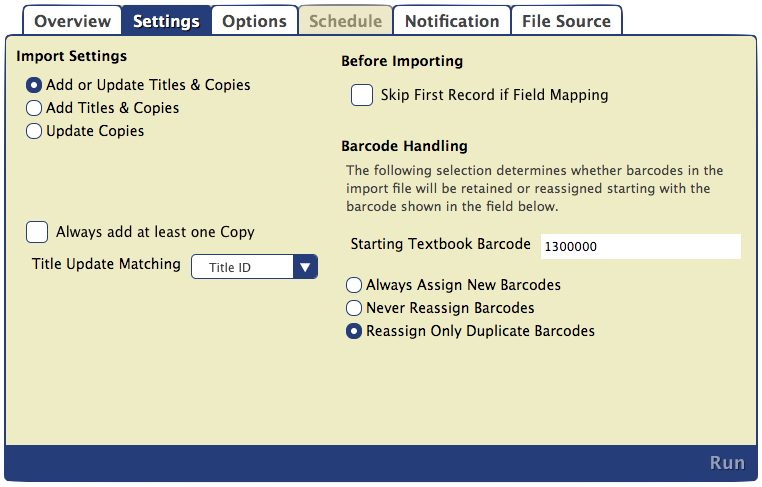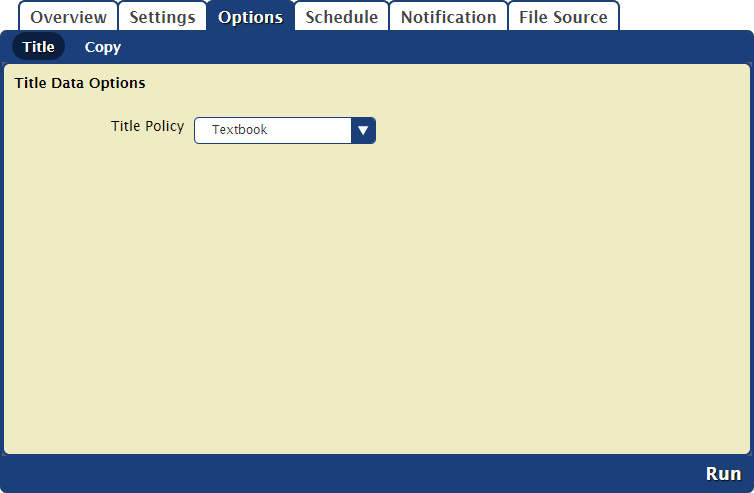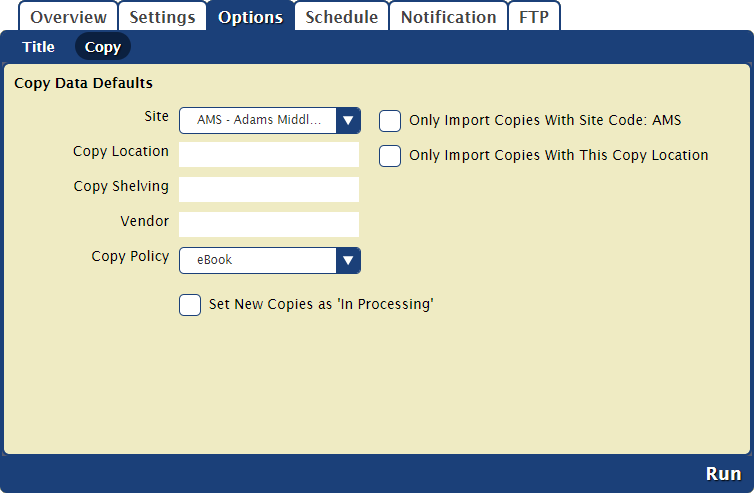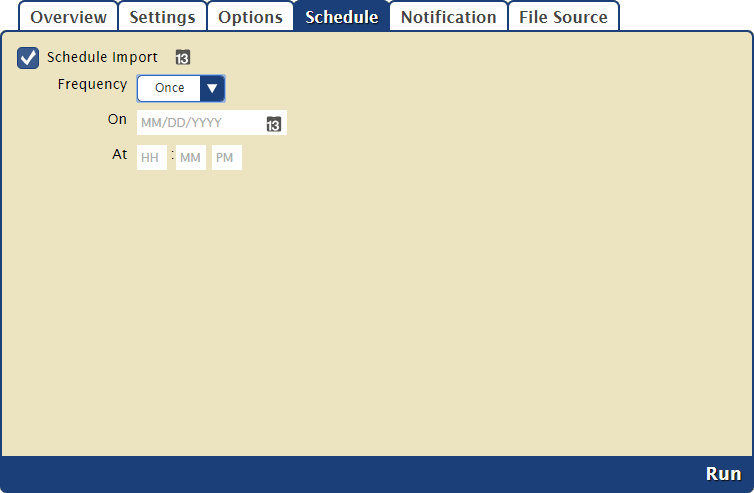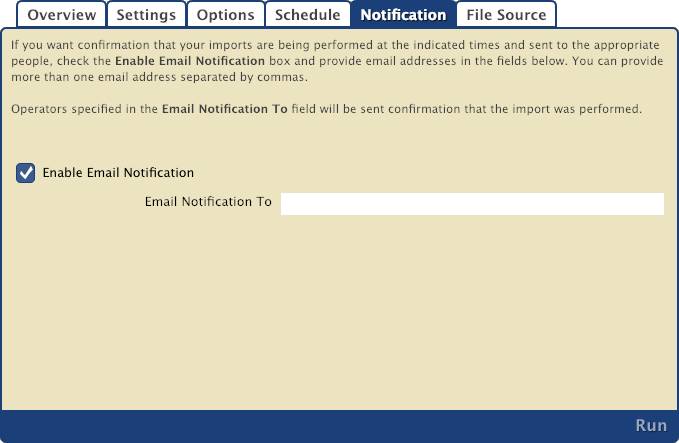Contents
Overview
Tools > Import > Textbooks > Saved tab
This is a brief summary of the import. The contents of this and other tabs may change based on the import you've selected.
Settings
Name
Enter a name for this saved import.
Created
Displays the name of the operator who created the import and their Site ID Code. It cannot be edited.
Notes
Enter general usage notes about the import here. Something like, "Only perform this import at the end of each month!"
Favorite
Save this to your favorites list for easy access.
Shared
Share this with other operators in your library or union. This is often helpful when particular imports are used frequently.
Settings
Tools > Import > Textbooks > Saved tab
This is where you configure how title and copy information is imported into your database.
Import Settings
Add or Update Titles & Copies
Add or update title and copy records. Copies will only be updated if they belong to the associated title record.
Add Titles & Copies
Add new title and copy records. Titles and copies cannot be updated with this setting.
Update Copies
Modify copy data in your collection based on the copy barcode. Title fields will be ignored.
Always add at least one Copy
This option specifies that at least ONE new copy is always added when the Title is added or modified. When adding a copy, the next available barcode is used. If one or more copies are added when the title is added or modified, additional copies are NOT added.
Before Importing
Skip First Record if Field Mapping
This is usually recommended when the first record in your import file contains an unrecognized header. The setting will ignore recognized COMPanion headers so they are imported properly.
Barcode Handling
The following settings determine if the barcodes in your import file will be retained or reassigned starting with the barcode number shown in the field below.
Staring Textbook Barcode
When a new item barcode number is required, Textbook Tracker will assign numbers beginning with the value you enter in this field. If a barcode is already in use, a new barcode will be automatically selected.
Always Assign New Barcodes
All item barcodes will be reassigned using the Starting Textbook Barcode number (above). If you know for sure that your vendor assigned “dummy” barcode numbers with your MARC records, you'll want to use this option to force Textbook Tracker to assign new barcode numbers according to the Next Barcode setting in your Patron Defaults preferences.
Never Reassign Barcodes
Trying to add copy data with duplicate barcode numbers will cause the imported record to be ignored. Use this setting if you want existing copy data to be updated, not reassigned.
Reassign Only Duplicate Barcodes
Imported barcodes that already exist in your database (duplicates) will not be reassigned. (Default)
Options
Tools > Import > Textbooks > Saved tab
Title
Copy
Schedule
Tools > Import > Textbooks > Saved tab
Use these settings to schedule this import to run on a regular basis.
Settings
Schedule
Check this box to unlock the scheduling options.
Frequency
This menu allows you to specify how often you would like to repeat your import: Once, Daily, Weekly, Monthly, or Yearly.
On
The options here depend on the frequency you selected above.
Once. Choose the date to run this import.
Daily. On options are not necessary if the import is run daily.
Weekly. Choose the day of the week to run this import.
Monthly. Choose the date the import will run each month.
Yearly. Choose the month and date the import will run each year.
At
Choose the time of day, including a.m. or p.m., to run the import.
Notification
Tools > Import > Textbooks > Saved tab
Here you can enable an email confirmation to be sent to the recipient(s) of your choice once the import is complete.
Settings
Enable Email Notification
Check this box if you want to enable email notifications to be sent upon completion.
Email Notification To
Enter the recipient email addresses. You can provide more than one email address separated by commas.
- For example: johndoe@examplelibrary.com,janedoe@examplelibrary.com
FTP
Tools > Import > Textbooks > Saved tab
You can import new or update existing textbooks from a record database stored on an FTP server. The options in this tab allow you to specify the (secure) FTP server URL and username/password credentials so Textbook Tracker can locate the import file.
If the connection
An import without a valid FTP connection is treated as if the FTP connection worked, but there was no file to import. In other words, no import is performed and the operations manager logs the data as shown for the notification email.
If more than ONE file is at the specified path (the path is a directory, not a single file), each file generates a separate operation entry in the operations manager. This means the download operation is separate from the import operation. For example, if there is a single file, this operation downloads it and schedules it in the operations queue. Although this operation is an import, the import is scheduled in a separate operation, just as if the user did and “immediate” import.
A valid FTP connection is required to schedule an import.
Settings
Protocol
Click here to choose FTP or FTPS (secured by SSL).
Host
Enter the host name or IP address of the FTP server without the URL protocol, such as myserveraddress.com.
Port
By default, FTP runs over port 21 and FTPS runs over port 990. You can manually enter a different port, if necessary.
Path
Enter the full path to the file, including directories and the filename, such as /directory/subdirectory/filename.txt.
Username and Password
Enter your FTP login credentials. If your FTP server is configured to allow anonymous connections, the username and password may not be necessary.
FTP, short for File Transfer Protocol, is a set of rules (language) used to transfer files between computers on a network, such as the internet. There are two computers involved in an FTP transfer: a server and a client. An FTP client is an application that allows you to upload, download, and otherwise manage files stored on the FTP server. There are several FTP clients available for free, such as FileZilla and Cyberduck.

